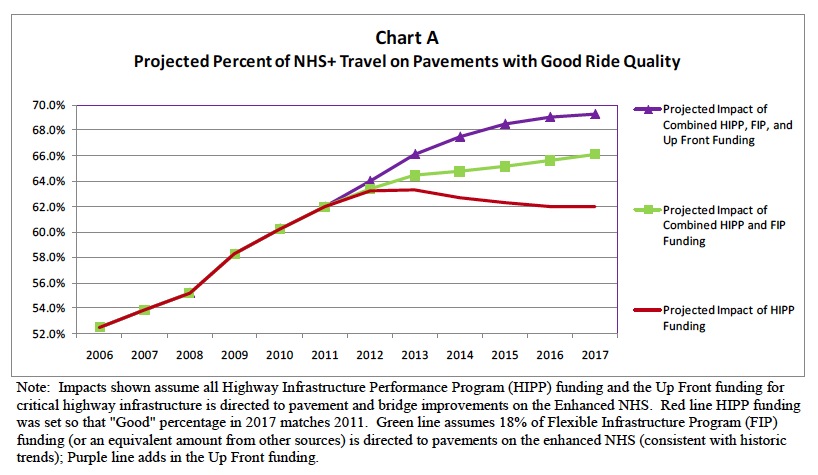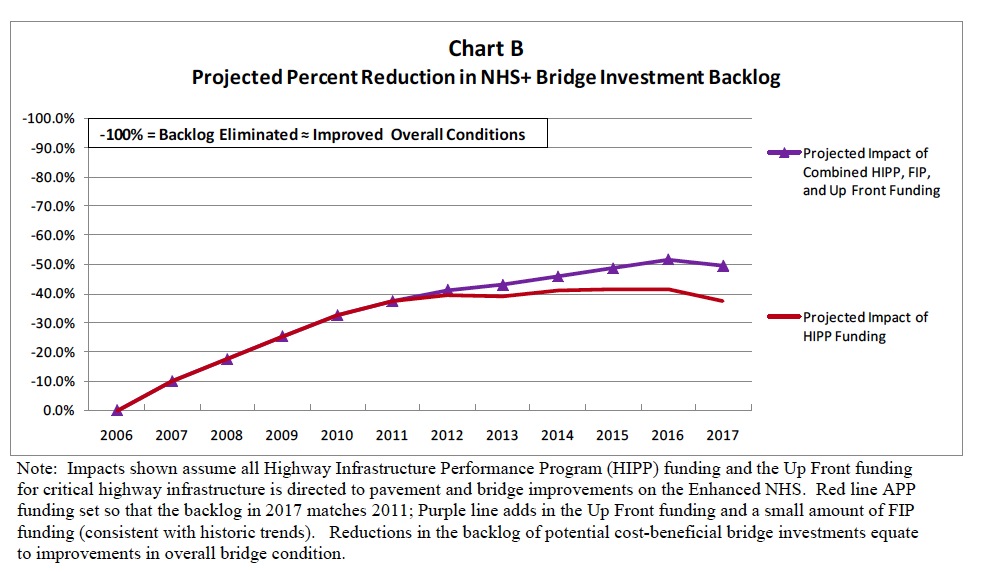FEDERAL HIGHWAY ADMINISTRATION
Overview
FHWA’s FY 2012 budget requests $70.5 billion ($69.9 billion net of rescission) and represents a new paradigm in funding our nation’s highways. This request represents the first year of the Administration’s six-year surface transportation reauthorization proposal, which provides $336 billion from FY 2012 to 2017 for highway programs. The proposal reflects a 48 percent increase in funding for road and bridge improvements and construction from the $227 billion authorized in the Safe, Accountable, Flexible, Efficient Transportation Equity Act: A Legacy for Users (SAFETEA-LU). The proposal will simplify the highway program structure and establish a performance-based highway program in the critical areas of safety and state of good repair. In addition, the proposal will fund transportation projects that improve quality of life in both rural and urban areas, provide users with enhanced transportation choices, improve air quality in large metropolitan areas, and encourage innovations that will shorten project delivery and accelerate the deployment of new technologies.
Built on past successes, the new structure is a significant departure from the previous seven years (FY 2005-2011) carried out under SAFETEA-LU and strives to enhance the safety, livability, condition, and efficiency of our nation’s highway system. The proposal consolidates over 55 programs, each with their own emphasis and eligibility requirements, and increases the flexibility to invest the funds. The new Federal-aid highway program consists of five core programs, an innovative multi-modal competitive grants program, a new office to study revenue alternatives and a general operating expenses account.
The revamped performance-based Highway Safety Improvement Program ($2.5 billion) almost doubles the Federal investment in highway safety programs to reduce fatalities and injuries on public roads in alignment with Department of Transportation’s (DOT) Roadway Safety Plan. This program will provide $2.2 billion for infrastructure oriented safety improvement projects, with the flexibility to use up to 25 percent of funds for education, enforcement and emergency medical services investments if needed to address specific safety problems in the State. The program also features funding for rural road safety, as well as a new $293 million Highway Safety Data Improvement Program designed to focus on improved State data collection, use of data to identify problems, and use of analytical tools and processes to identify and prioritize safety treatments. Each State will develop a Strategic Highway Safety Plan that will address how all available funds (Federal, state, and local) will be used to achieve safety performance targets. States will also be required to develop an annual spending program to implement the highway elements in the Strategic Highway Safety Plan.
The new performance-based National Highway Program ($32.4 billion) targets investment to maintain a state of good repair on roads critical to national interest while also providing flexibility to the States for making transportation investment decisions on the larger system of Federal-aid eligible highways. The National Highway Program funds investments targeted at reducing traffic congestion and making freight movement more efficient, which supports DOT’s economic competitiveness strategic goal and the Administration’s National Export Initiative.
The proposal streamlines and consolidates portions of several existing programs including Interstate Maintenance, National Highway System, Highway Bridge, and the Surface Transportation Program into two new subprograms:
- Highway Infrastructure Performance Program – A $16.75 billion formula-based program designed to improve the infrastructure condition and performance on an expanded National Highway System. This 220,000-mile network includes the Interstate System, all principal arterials, intermodal connectors, and other roads important to mobility, commerce, national defense, and intermodal connectivity. The enhanced system is an objectively defined network of national interest that will operate as a cohesive highway system to support interstate commerce and economic competitiveness, which will carry 55% of all traffic and 97% of all truck-borne freight.
- Flexible Investment Program – A $15.6 billion formula-based program that provides flexibility to the States to invest in infrastructure preservation, congestion mitigation, or performance improvement projects on the 995,000 miles of Federal-aid eligible highways.
Download the full version (PDF): Federal Highway Administration Budget Estimates: Fiscal Year 2012
About the Federal Highway Administration
http://www.fhwa.dot.gov/
“The Federal Highway Administration (FHWA) is an agency within the U.S. Department of Transportation that supports State and local governments in the design, construction, and maintenance of the Nation’s highway system (Federal Aid Highway Program) and various federally and tribal owned lands (Federal Lands Highway Program). Through financial and technical assistance to State and local governments, the Federal Highway Administration is responsible for ensuring that America’s roads and highways continue to be among the safest and most technologically sound in the world.”
Tags: Budget, Federal Highway Administration, FHWA, Fiscal Year 2012








 RSS Feed
RSS Feed